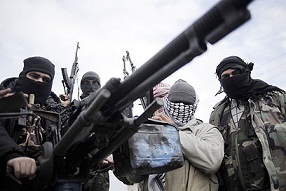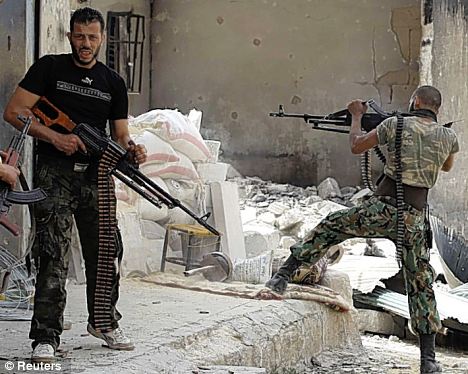With help from the American C.I.A., Arab governments and Turkey have sharply increased their military aid to Syria’s opposition fighters in recent months.
 With help from the American C.I.A., Arab governments and Turkey have sharply increased their military aid to Syria’s opposition fighters in recent months, expanding a secret airlift of arms and equipment for the uprising against Syrian government, the American New York Times daily reported.
With help from the American C.I.A., Arab governments and Turkey have sharply increased their military aid to Syria’s opposition fighters in recent months, expanding a secret airlift of arms and equipment for the uprising against Syrian government, the American New York Times daily reported.
According to air traffic data, interviews with officials in several countries and the accounts of rebel commanders, the newspaper stated that the airlift, which began on a small scale in early 2012 and continued intermittently through last fall, expanded into a steady and much heavier flow late last year.
“It has grown to include more than 160 military cargo flights by Jordanian, Saudi and Qatari military-style cargo planes landing at Esenboga Airport near Ankara, and, to a lesser degree, at other Turkish and Jordanian airports,” the daily said.
“From offices at secret locations, American intelligence officers have helped the Arab governments shop for weapons, including a large procurement from Croatia, and have vetted rebel commanders and groups to determine who should receive the weapons as they arrive,” it added.
The C.I.A. declined to comment on the shipments or its role in them.
The New York Times also highlighted the visit of Secretary of State John Kerry to Iraq on Sunday to press it to do more to halt Iranian arms shipments through its airspace; noting that “he did so even as the most recent military cargo flight from Qatar for the rebels landed at Esenboga early Sunday night.”
Most of the cargo flights have occurred since November, after the presidential election in the United States and as the humanitarian crisis inside Syria deepened in the winter and cascades of refugees crossed into neighboring countries.
“A conservative estimate of the payload of these flights would be 3,500 tons of military equipment,” the US daily quoted Hugh Griffiths, of the Stockholm International Peace Research Institute, who monitors illicit arms transfers, as saying.
The daily also confirmed that Qatar and Saudi Arabia had been shipping military materials via Turkey to the opposition since early and late 2012, respectively.
“Simultaneously, arms and equipment were being purchased by Saudi Arabia in Croatia and flown to Jordan on Jordanian cargo planes for rebels working in southern Syria and for retransfer to Turkey for rebels groups operating from there,” it added citing several officials.
 “These multiple logistics streams throughout the winter formed what one former American official who was briefed on the program called “a cataract of weaponry,” it added.
“These multiple logistics streams throughout the winter formed what one former American official who was briefed on the program called “a cataract of weaponry,” it added.
The daily also revealed that on Jan. 3, 2012, a pair of Qatar Emiri Air Force C-130 transport aircraft touched down in Istanbul, according to air traffic data.
By late midspring, the first stream of cargo flights from an Arab state began, according to air traffic data and information from plane spotters.
On a string of nights from April 26 through May 4, a Qatari Air Force C-17 — a huge American-made cargo plane — made six landings in Turkey, at Esenboga Airport. By Aug. 8 the Qataris had made 14 more cargo flights. All came from Al Udeid Air Base in Qatar, a hub for American military logistics in the Middle East.
The former American official told the daily that David H. Petraeus, the C.I.A. director until November, had been instrumental in helping to get this aviation network moving and had prodded various countries to work together on it. Mr. Petraeus did not return multiple e-mails asking for comment.
“The American government became involved, the former American official said, in part because there was a sense that other states would arm the rebels anyhow. The C.I.A. role in facilitating the shipments, he stated, gave the United States a degree of influence over the process,” it said.
“American officials have confirmed that senior White House officials were regularly briefed on the shipments.”
Soon, other players joined the airlift: In November, three Royal Jordanian Air Force C-130s landed in Esenboga, in a hint at what would become a stepped-up Jordanian and Saudi role.
“Within three weeks, two other Jordanian cargo planes began making a round-trip run between Amman, the capital of Jordan, and Zagreb, the capital of Croatia, where, officials from several countries said, the aircraft were picking up a large Saudi purchase of infantry arms from a Croatian-controlled stockpile,” the US news paper stressed.
According to the New York Times, records show that two Jordanian Ilyushins bearing the logo of the Jordanian International Air Cargo firm but flying under Jordanian military call signs made a combined 36 round-trip flights between Amman and Croatia from December through February. The same two planes made five flights between Amman and Turkey this January.
"As the Jordanian flights were under way, the Qatari flights continued and the Royal Saudi Air Force began a busy schedule, too — making at least 30 C-130 flights into Esenboga from mid-February to early March this year, according to flight data provided by a regional air traffic control official.”
The daily pointed out that the Turkish and Saudi officials declined to discuss the flights or any arms transfers.
